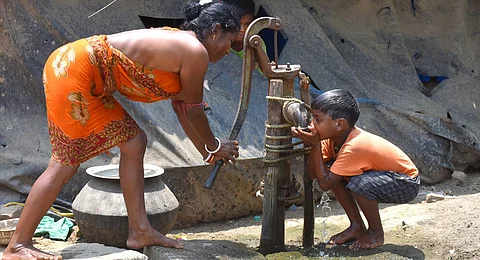

LALGARH : Dhangri Kusum, a small village located along the border of West Bengal and Jharkhand, is home to about 125 families. Motilal Singh’s family is among 10 others who are engaged in the traditional craft of making stone pots. They produce five small stone pots daily, each selling for Rs 100, or two larger pots priced at Rs 500. The stone they use is from the nearby jungle.
However, the village faces a severe health crisis. Chunu Singh, a 58-year-old stone carver, has been crafting stone for the last 25 years. For 15 years, he has been battling tuberculosis, which has severely impacted his ability to work and live a normal life.
Another craftsman, 45-year-old Kadal Singh, has also been suffering from TB for five years. Before his health deteriorated, Kadal earned between Rs 100 and Rs 200 per day. Now, his condition prevents him from working, and his wife has taken up work in paddy fields, earning only Rs 150 per day, barely enough to support the family. Their five-year-old son often relies on neighbours for food. Despite TB medication being free, Kadal cannot afford the nutritious food necessary to aid his recovery.

The plight of these families highlights the urgent need for better healthcare and support in Dhangri Kusum. Without sufficient income and nutrition, the cycle of illness and poverty continues to devastate the lives of these adivasis who are skilled artisans.
In 2010, Lalgarh was known for conflict and violence. This changed over the past 14 years due to the construction of a state highway and a bridge between Jhargram and Lalgarh. These projects have transformed the area, bringing development and improving the residents’ lives.
Before 2008, Lalgarh was largely unknown until it became the hub of Maoist insurgency. The ‘red rebels’, led by the CPI (Maoist), attacked police and even tried to kill the then Bengal CM Budhadeb Bhattacharya. The conflict peaked in 2010 with the tragic derailment of the Jnaneswari Express near Jhargram, killing 148 people.

To stop the violence, the Centre launched a massive counter-insurgency operation in the Jangal Mahal region, which includes Lalgarh and Jhargram. From 2011 to 2020, the state police and the Central Reserve Police Force worked together to break the Maoist stranglehold on the area.
Alongside these security efforts, new infrastructure was built. The state highway and a bridge improved connectivity, making travel and trade easier. This has helped Lalgarh move from conflict towards stability.
Today, Lalgarh has changed — people are now well-connected to both Jhargram and Midnapur. Roads and water facilities have improved. Local people say the past violence forced politicians to rethink their problems in Lalgarh. They believe that the past violence ultimately led to a smoother life to ensure that the next generation does not struggle for survival.

In contrast, Belpahar, another tribal hamlet, still lacks potable water and healthcare. During the summer, the situation is especially bad. Being further from the district headquarters, Belpahar lacks political attention, which is pushing its tribes towards violence. The contrast between Lalgarh and Belphar shows the importance of political will and infrastructure in improving people’s lives.
Many homestays and resorts have cropped up in Jangalmahal, but lives of local people remain unchanged. They are still miles away from healthcare and water facilities. Although a few houses built under the PM Awas Yojana are scattered across a largely neglected land, drinking water — mostly dependent on a small rainwater-fed system that dries up in the hot summer — is available only for 10 minutes a day. In Belpahar, one has to wait for a water tanker.